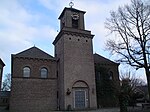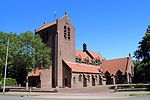Huissen
Cities in the NetherlandsFormer municipalities of GelderlandLingewaardMunicipalities of the Netherlands disestablished in 2001Pages with Dutch IPA ... and 1 more
Populated places in Gelderland

Huissen (Dutch pronunciation: [ˈɦysə(n)]) is a city with city rights in the Netherlands, in the province of Gelderland. The town is located in the Betuwe region and belongs to the municipality of Lingewaard, in the area between the major cities of Arnhem and Nijmegen. Huissen is situated along the rivers Nederrijn and Linge. The city has a population of 19,414 (as of 1 January 2020).
Excerpt from the Wikipedia article Huissen (License: CC BY-SA 3.0, Authors, Images).Huissen
Laaksevoetpad, Lingewaard
Geographical coordinates (GPS) Address Nearby Places Show on map
Geographical coordinates (GPS)
| Latitude | Longitude |
|---|---|
| N 51.933333333333 ° | E 5.9333333333333 ° |
Address
Laaksevoetpad 20
6851 GW Lingewaard
Gelderland, Netherlands
Open on Google Maps









